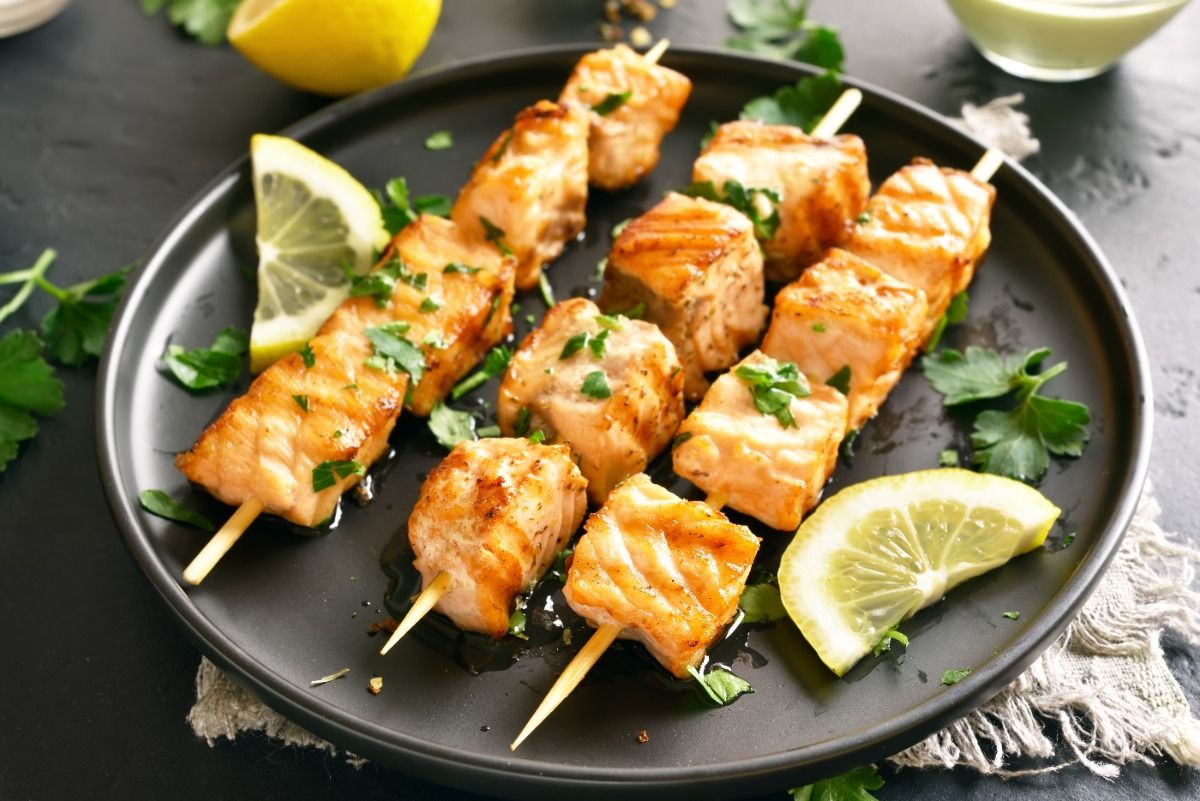
If you’re pregnant and on a pescatarian diet, you might have heard from your doctor to be careful of mercury. If you’ve ever been to a prenatal doctor’s visit, you’ve probably heard that list of Foods Not to Eat when You’re Expecting. Some doctors’ lists are longer than others, but the three biggies across the board are no raw eggs, no raw fish, and not too much tuna.
Doctors recommend limiting tuna intake during pregnancy because of its mercury content. While eating average amounts of mercury-containing seafood while being pregnant and on the pescatarian diet has not been shown to cause any problems in fetal brain development, excessive amounts can be harmful. The accepted recommendation for women of childbearing age, pregnant women, and children is no more than 12 ounces of chunk light tuna or 6 ounces of Albacore tuna each week (Albacore is higher in mercury than chunk light). But your doctor might not point out that it’s not only tuna that is relatively high in mercury. Salmon is, too. And when you are trying to limit your mercury intake, those 12 weekly ounces are the limit for both tuna and salmon combined.

Eating Tuna and Salmon While on the Pescatarian Diet During Pregnancy
Tuna and salmon can provide important health benefits during pregnancy. One of the main benefits of eating seafood is its omega-3 fatty acid content. (Other sources include chia and hemp seeds and olive, coconut and avocado oil.) In pregnant women, omega-3 fatty acids have been shown to increase baby’s birth weight, enhance fetal brain development, improve mother’s mood, and avoid preterm labor and other complications. Plain and simple, omega 3 optimizes the body’s ability to support another living being.
But not all fish contain omega-3 fatty acids as richly. Wild salmon, which grows up in its natural habitat and thrives on an omega-3 rich diet, provides the most optimal, inflammation-busting ratio of omega-3 to omega-6 fatty acids. Some find it hard to tolerate because of its “fishy” taste. It’s also the most expensive salmon on the market. The alternative, farm-raised salmon, is somewhat lower in mercury than wild, but in most cases its diet consists of more omega-6 fatty acids than omega-3, lowering the fish’s anti-inflammatory properties. Many farms also inject their salmon with antibiotics and dyes to enhance growth and make them more attractive. Like antibiotics in meat and chicken, these injections can mess with our hormones, cycles and health.
Personally, the strong fishy taste and smell of wild fish was something I just couldn’t get used to, and I avoided salmon for years. But recently, I discovered a third option: a special farm-raised salmon that is fed an omega-3 rich diet, is free of dyes and antibiotics, and is third-party certified to be significantly lower in mercury and PCBs than standard farm-raised fish. With its high omega-3 to omega-6 ratio, this fish is a really healthy choice for those who prefer a very clean-tasting salmon. And because of its lower mercury content, you can even ask your doctor if the weekly limit can be a bit higher than 12 ounces.
If you are okay with the price and taste of wild salmon, go for it. Just be mindful of how much you eat every week. Keep your combined tuna and salmon intake to the recommended limit and switch off with other proteins, like eggs, chicken, turkey, meat, Greek yoghurt and other high protein dairy products. You can even get some protein from vegan sources, like nuts, seeds, beans, pseudo-grains and even good-quality protein powders. And if you do opt for farm-raised salmon, be an educated consumer. Talk to your local fish store manager and inquire about organic-fed farm-raised fish with no growth hormones, antibiotics or dyes. I have found that fish stores and even fish departments in grocery stores are on the lookout for healthier options to accommodate informed, health conscious customers.
It’s always important to be vigilant about your health. And that rings even truer when you’re taking care not only of yourself, but of a precious little bundle who relies on you for proper nourishment for his or her optimal growth and development.

Pescatarian Recipe: Sesame Crusted Salmon Skewers
Below is a recipe for those of you who are pregnant and on the pescatarian diet (or even if you’re not! It’s a delicious recipe.)
You will need:
20 1” by 1” cubes skinned salmon fillet
Oil spray (I use avocado oil)
2 tablespoons tahini paste
½ teaspoon toasted sesame oil
1 tablespoon orange juice
2 tablespoons coconut aminos
1 ½ teaspoons salt
1 teaspoon rice vinegar
1 cup sesame seeds
Instructions:
Preheat the oven to 425°F. Grease a cookie sheet with oil.
In a small bowl, whisk together all ingredients besides the salmon and sesame seeds. Mix salmon cubes into sauce. Allowing the salmon to marinate will intensify the flavor, so if you can, marinate for an hour or more.
Pour the sesame seeds onto a plate and roll the salmon cubes in them to coat. Stick 2 cubes on a skewer and place on the prepared cookie sheet, making sure the skewers are not touching each other. Bake for 14-18 minutes or until the sesame seeds start turning golden and the salmon is cooked through. Serve hot, at room temperature, or cold.
Note: To make this a delicious macro meal, you can serve over quinoa with stir-fried veggies.
Final Thoughts
Healthy means something different for everyone, especially if you need to avoid certain ingredients because of the diet you’re on. Many recipes will offer a few variations, like gluten-free, nut-free, egg-free, and even refined sugar-free, so that you can customize them to your and your family’s preference.
For more wholesome recipes, check out the new cookbook, Food You Love: That Loves You Back.
To find out the optimal diet for you based on your genetics, read your nutrition profile from CircleDNA.






